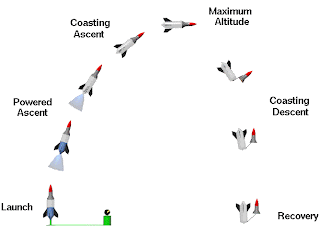Flying model rockets is a relatively safe and inexpensive way for students to learn the basics of forces and the response of a vehicle to external forces. A model rocket is subjected to four forces in flight; weight, thrust, and the aerodynamic forces, lift and drag. The relative magnitude and direction of the forces determines the flight trajectory of the rocket.
On this page we show the events in the flight of a water rocket. Water rockets are among the simplest type of rocket that a student encounters. The body of the rocket is an empty, plastic, two-liter soda bottle. Cardboard or plastic file fins are attached to the bottom of the bottle for stability, and a fairing and nose cone are added to the top as a payload.
Prior to launch, the body of the rocket is filled with water to some desired amount, normally about 1/3 of the volume. The rocket is then mounted on a launch tube which is quite similar to that used by a compressed air rocket. Air is pumped into the bottle rocket to pressurize the bottle and thrust is generated when the water is expelled from the rocket through the nozzle at the bottom. Like a full scale rocket, the weight of the bottle rocket is constantly changing during the powered ascent, because the water is leaving the rocket. As the water leaves the rocket, the volume occupied by the pressurized air increases. The increasing air volume decreases the pressure of the air, which decreases the mass flow rate of water through the nozzle, and decreases the amount of thrust being produced. Weight and thrust are constantly changing during the powered portion of the flight. When all of the water has been expelled, there may be a difference in pressure between the air inside the bottle and the external, free stream pressure. The difference in pressure produces an additional small amount of thrust as the pressure inside the bottle decreases to ambient pressure. When the pressures equalize, there is no longer any thrust produced by the rocket, and the rocket begins a coasting ascent.
The remainder of the flight is quite similar to the flight of a ballistic shell, or a bullet fired from a gun, except that aerodynamic drag alters the flight trajectory. The vehicle slows down under the action of the weight and drag and eventually reaches some maximum altitude which you can determine using some simple length and angle measurements and trigonometry. The rocket then begins to fall back to earth under the power of gravity. Bottle rockets may include a recovery system like a parachute, or a simple detachment of the payload section, as shown in the figure. After recovering the rocket, you can fly again.
On the graphic, we show the flight path as a large arc through the sky. Ideally, the flight path would be straight up and down; this provides the largest maximum altitude. But water rockets often turn into the wind during flight because of an effect called weather cocking. The effect is the result of aerodynamic forces on the rocket and cause the maximum altitude to be slightly less than the optimum. The parabolic arc trajectory also occurs if the launch platform is tilted and the rocket is launched at an angle from the vertical.
Sumber : NASA water rocket article.
Ahad, 1 Ogos 2010
Langgan:
Catat Ulasan
(
Atom
)

Tiada ulasan :
Catat Ulasan
Pertanyaan anda akan dijawab..sila kembali semula ke blog ini